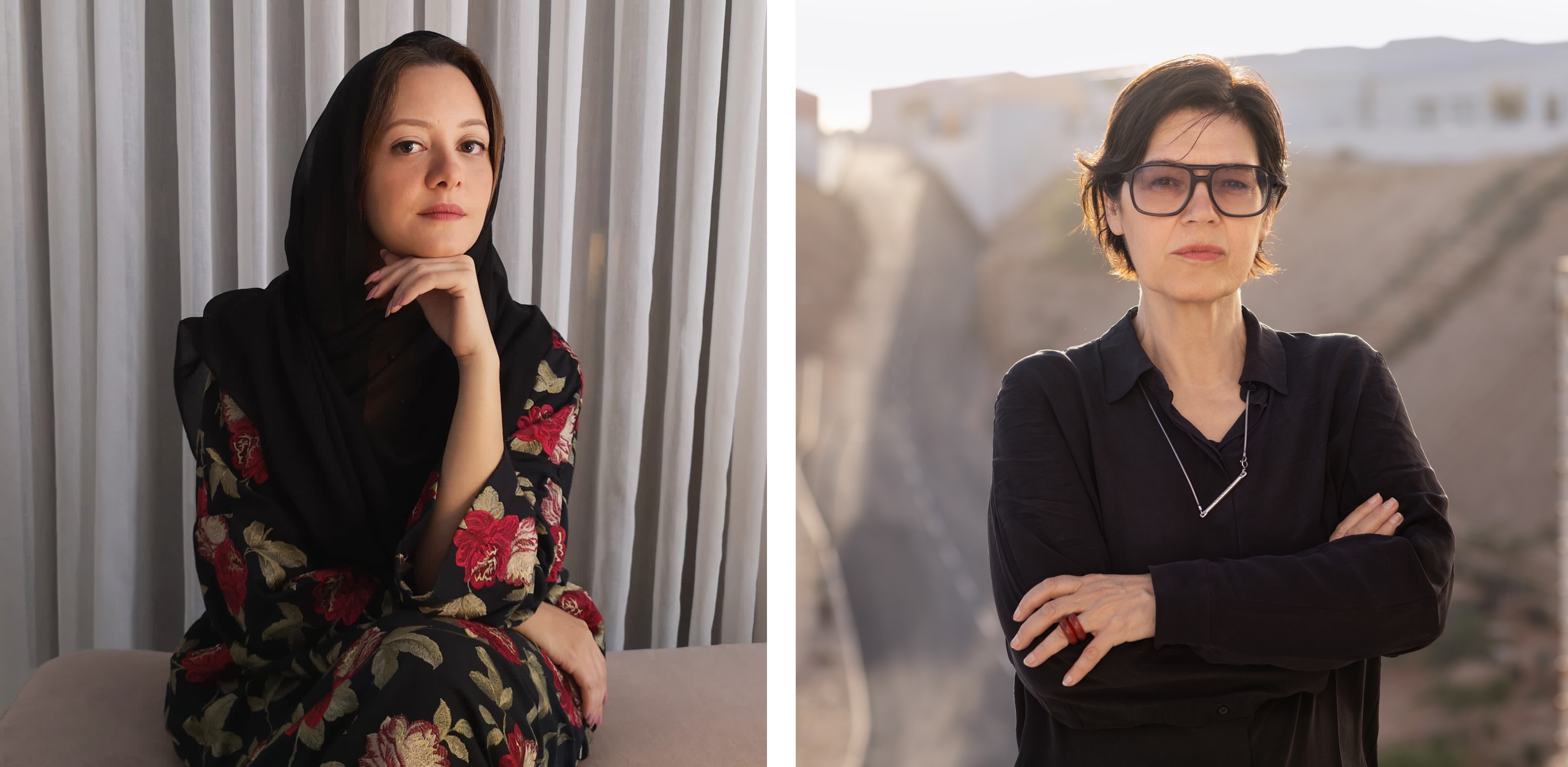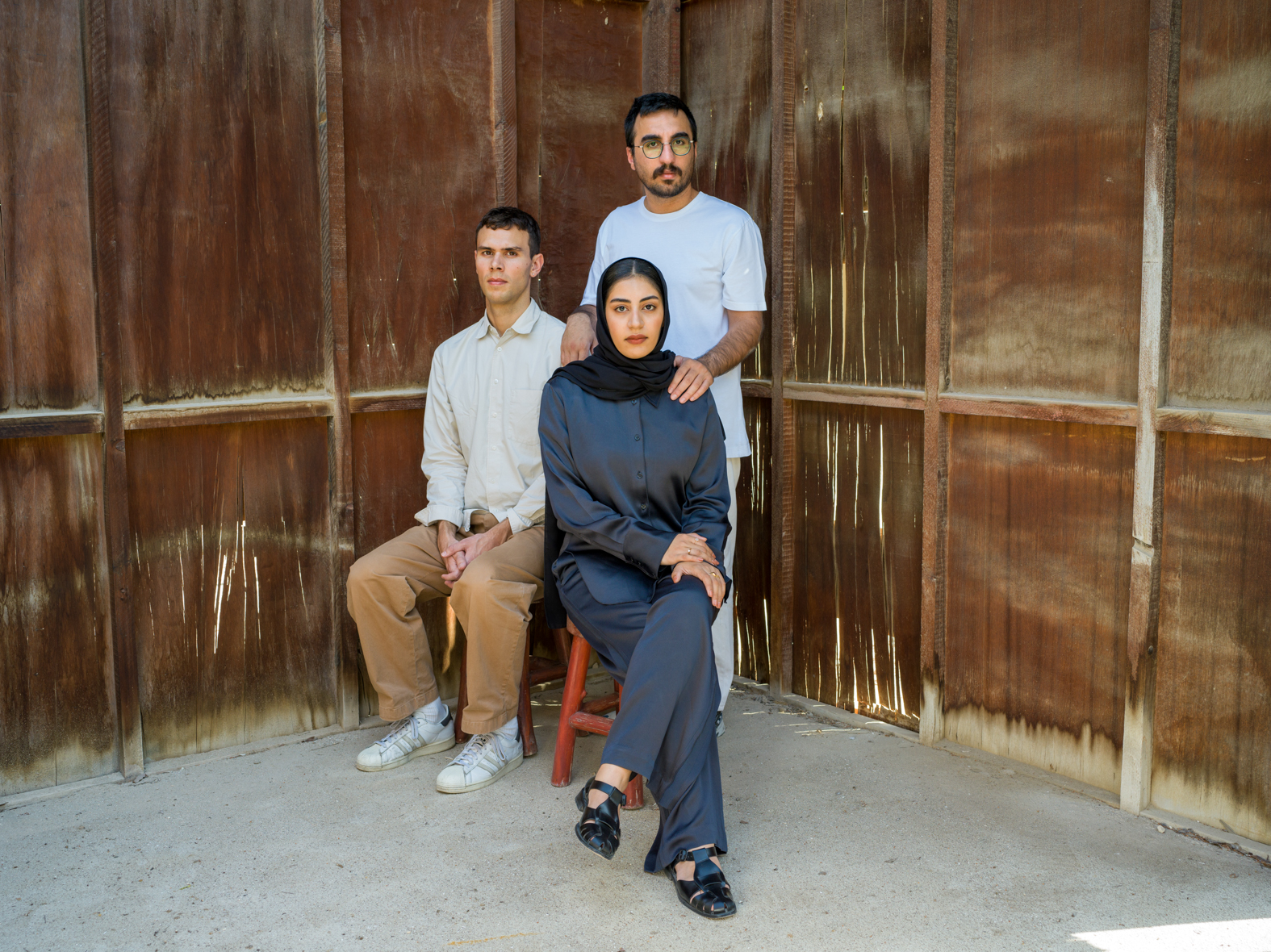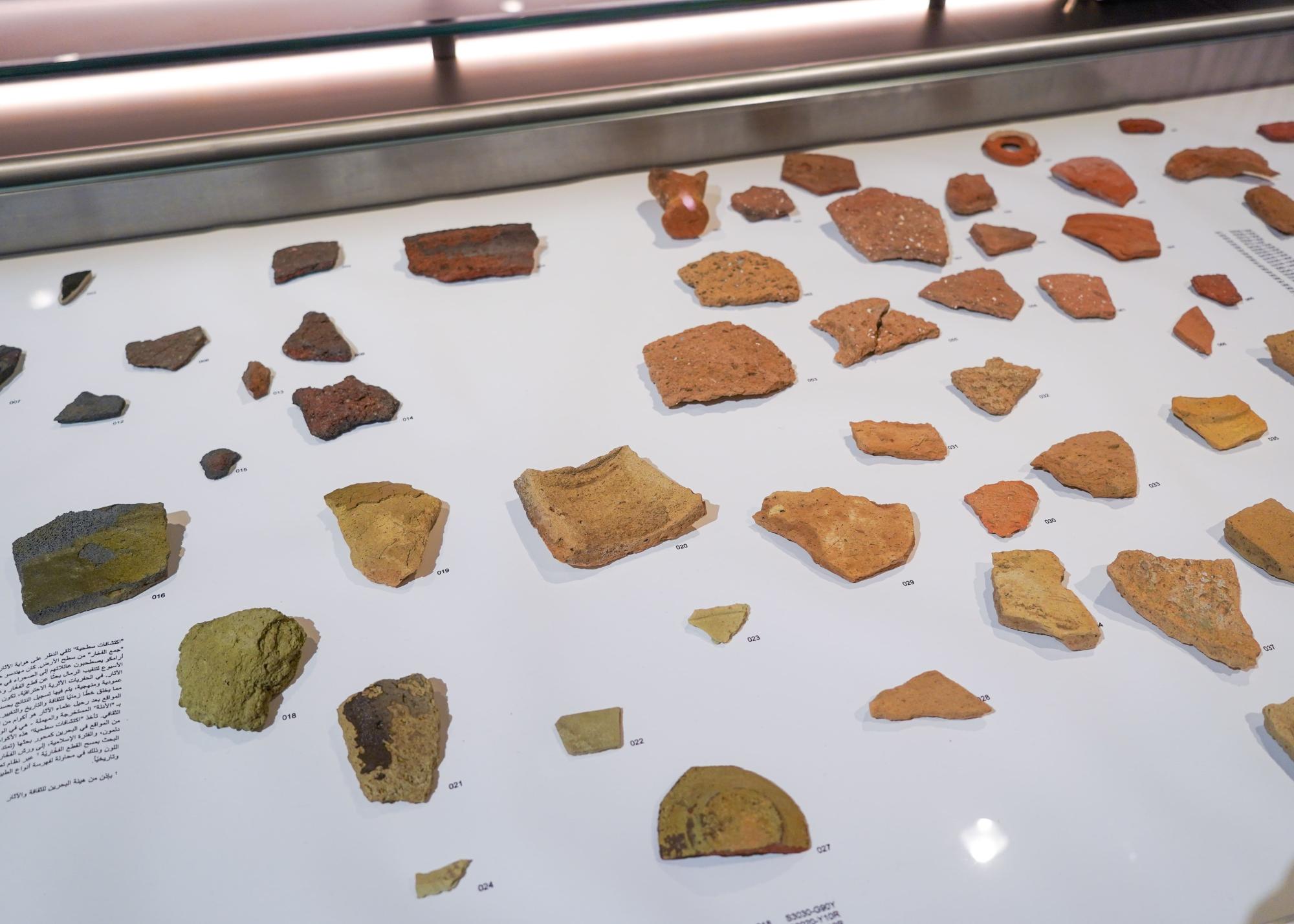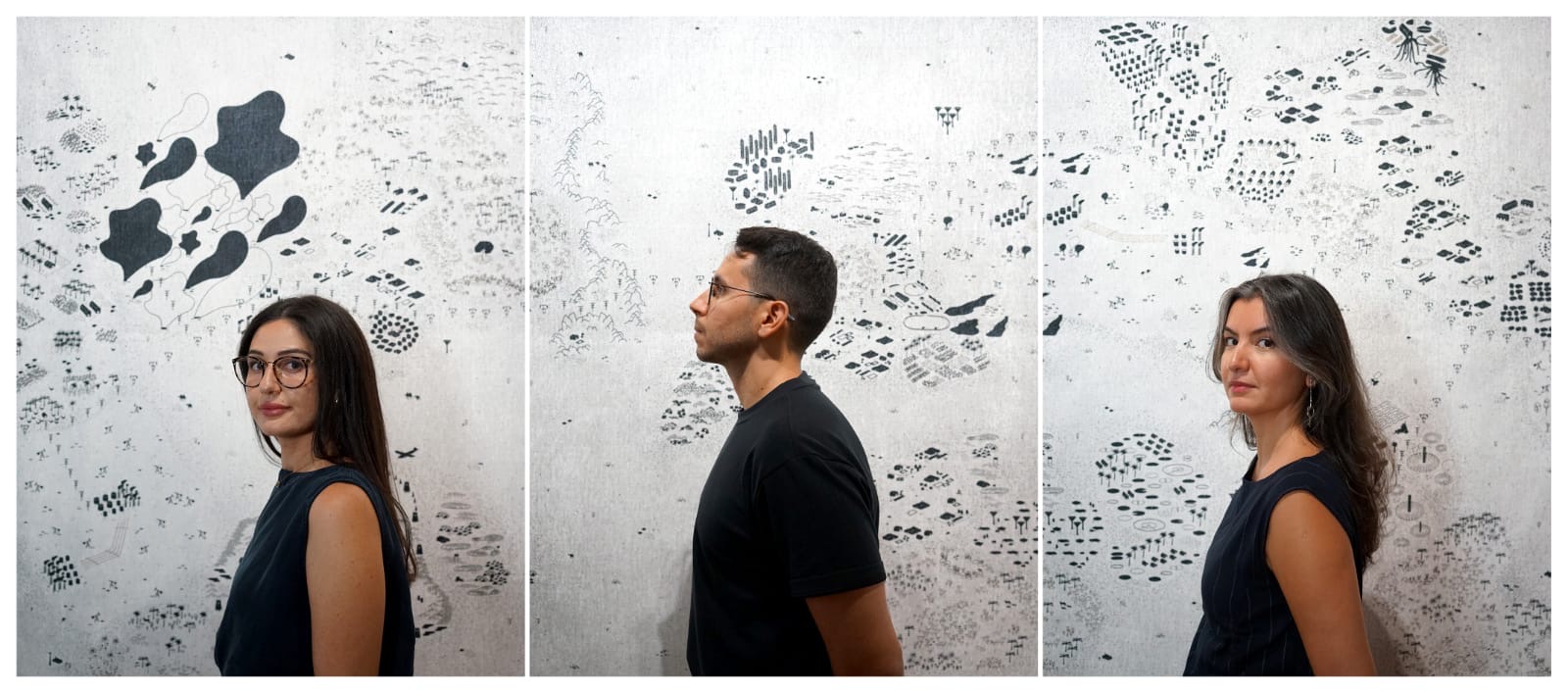
 Zurück
Zurück
Krinzinger Schottenfeld
curated by Ute Meta Bauer & Wejdan Reda


Ute Meta Bauer (geb. 1958 in Stuttgart) ist Kuratorin und Professorin an der School of Art, Design and Media der Nanyang Technological University in Singapur, wo sie auch das NTU Centre for Contemporary Art gründete. Sie war Künstlerische Leiterin der Diriyah Contemporary Art Biennale 2024. Zuvor hatte sie leitende Positionen am MIT, beim Office for Contemporary Art Norway und am Künstlerhaus Stuttgart. Bauer war u. a. Co-Kuratorin der Documenta11 (2002), Künstlerische Leiterin der 3. Berlin Biennale (2004) und Co-Kuratorin des US-Pavillons auf der Biennale von Venedig 2015. Ihr kuratorisches Interesse gilt den Schnittstellen von Kunst, Gesellschaft und Ökologie.
Wejdan Reda (geb. 1992, Dschidda) ist eine saudische Kuratorin für zeitgenössische Kunst und Gründerin von Sahaba, einer Kunstberatungs- und Forschungseinrichtung. Sie ist Interimsdirektorin der 2. Islamic Arts Biennale (2025) und war Ko-Kuratorin der 1. und 2. Diriyah Biennale für zeitgenössische Kunst (2021, 2024), sowie Ko-Kuratorin des ersten Voreröffnungsprogramms der Villa Hegra, das Programme und Ausstellungen in AlUla (2024) und Grand Palais (2025) umfasste. Zuvor war sie unter anderem Kuratorin bei Art Jameel (2020) und Co-Kuratorin von „Every Second In Between“ (2018) in London. Wejdan Reda hat einen MA in Curating Contemporary Art vom Royal College of Art.


Abdus illustrative Praxis mit anthropomorphisierten melancholischen Figuren beschäftigt sich intensiv damit, wie Menschen ihre inneren Räume verhandeln. Dabei untersucht sie häufig Themen wie das Selbst, Erinnerung, Heimat, Sterblichkeit und Unsterblichkeit, mit beiläufigen Hinweisen auf das bewusste und unbewusste Denken. Seit 2017 erforscht ihre Arbeit Strategien der Verkörperung und arbeitet auf zeitlichen, räumlichen, emotionalen und persönlichen Ebenen – sei es im meditativen Zustand, der durch ihren aufwendigen, mühevollen Prozess entsteht, oder durch die Bedeutung der von ihr gewählten Materialien. In ihren jüngsten Arbeiten erweitert Abdu ihre Praxis hin zu sinnlichen, mnemonischen Installationen, die die Betrachter in meditative und poetische Prozesse von Versöhnung und Erinnerung einladen.
In For Now That I’ve Lost You in My Dreams Where Do We Meet? (2021) verewigt Abdu Traumlandschaften in festen Seifenstrukturen, inspiriert vom Ritual der Parfümierung des Körpers in der islamischen Bestattungstradition. Sie erschuf eine geschwungene Gitterwand aus Seifenstücken, indem sie Sidr und Kampfer mischte – ein Versuch, sich mit dem Tod und dem Ende aller Erinnerungen auseinanderzusetzen.
The Infinite Now (2022) besteht aus fünfzehn hängenden Papierstücken, auf denen Abdu versucht, mit Henna als Tinte eine gerade Linie zu ziehen – ein Medium, das Zeit symbolisiert, da es von ihr beeinflusst wird. Durch diesen Akt der Wiederholung und Hingabe entsteht ein Werk, das als Ganzes eine Dokumentation des unendlichen Jetzt darstellt. In einer verwandten Werkreihe löst Abdu die Kontrolle der Künstlerin auf, indem sie sich auf die automatischen Bewegungen ihrer Hand beim Zeichnen konzentriert. Anstatt eine vorgefasste Komposition umzusetzen, lässt sie das Kunstwerk im Laufe der Zeit aus diesen repetitiven, unbewussten Handlungen entstehen. Mit diesen Arbeiten untersucht Abdu die Frage: „Kann Transzendenz durch Wiederholung erreicht werden, um einen inneren Zustand des wahren Selbst zu erlangen, losgelöst von äußeren Ablenkungen?“
Abdu besitzt ein Diplom in Grafikdesign und Digitaler Kunst vom Future Institution of Higher Education and Training sowie einen Bachelor of Arts in Englischer Sprache und Literatur von der Arab Open University. 2017 war sie Artist in Residence an der Cité internationale des Arts in Paris, Frankreich.
Ausgewählte Ausstellungen umfassen Amakin, kuratiert von Ventia Porter, Ithra, Dammam, KSA, 2022; Artissima Art, Turin, Italien, 2021; I Only Meant To Visit, 21,39 ATHR Gallery, Jeddah, KSA, 2021 (Einzelausstellung); Zamakan, Ithra, Dammam, KSA, 2019; und The Intangible Bonds in Our Existence, ATHR Gallery, Jeddah, KSA, 2014 (Einzelausstellung).
Abdus Werke sind in der BIC Art Collection vertreten.


As an artist, film director and writer, he explores the complex relations that connect humans, animals and fantastic creatures together. Sensitive to oral traditions and legends that populate his native country’s collective imaginary, AlFaraj draws inspiration from the social practices and architectures, whether urban or rural, of everyday life. Interested in the relationship between form and concepts, he creates multimedia works from fictional and non-fictional sources that draw on contemporary social and environmental issues.
AlFaraj graduated with a BA in mechanical engineering from King Fahd University of Petroleum and Minerals (KFUPM) in 2017. His work has been shown in various international solo and group shows, including the Islamic Arts Biennale, 2023; 16th Biennale de Lyon, 2022; Jameel Arts Centre, 2022; 21,39 Jeddah Arts, 2020; Athr Gallery, Jeddah (2020, 2018); the Sharjah Islamic Festival, 2019; the Sharjah Art Foundation, 2019; Le Murate Pac, Florence, 2019; 21,39 Jeddah Arts, 2017 & 2019; Saudi Film Festival, Dammam, 2015 and Dubai International Film Festival, 2014. He participated in 2019 in the Can Serrat – International Art Residency, Barcelona, and more recently in the AlUla Art Residency in 2022.


Nasser Al Salem ist ein zeitgenössischer Kalligraf, der die arabische Schrift neu interpretiert und ihre Grenzen durch unkonventionelle Mixed-Media-Formen und konzeptuelle Ansätze erweitert. Geboren in Mekka, wuchs Al Salem in unmittelbarer Nähe zur heiligen Kaaba auf. Er war tief in die spirituelle und kulturelle Atmosphäre der Stadt eingebunden und besuchte als Jugendlicher Kalligrafiekurse innerhalb der Moschee. Die Zeltmachertradition seiner Familie verwurzelte ihn zusätzlich in der regionalen Handwerks- und Kulturgeschichte.
Al Salem studierte Architektur an der Umm-Al-Qura-Universität, wo er seine künstlerische Leidenschaft mit architektonischem Denken verband. Seine Werke verbinden analytische Präzision mit kreativer Ausdruckskraft. Heute lebt und arbeitet er in Riad als Architekt und ist aktives Mitglied der National Guild of Calligraphers.
Seine künstlerische Praxis geht weit über die visuelle Ästhetik der arabischen Schrift hinaus – sie befasst sich mit deren spiritueller und konzeptueller Dimension. Inspiriert von seiner architektonischen Ausbildung verfolgt Al Salem einen dreigliedrigen Ansatz, der Wort, Medium und Ästhetik miteinander verbindet. So entstehen vielschichtige Arbeiten, die den Betrachter dazu auffordern, Sprache über ihre traditionelle Form hinaus zu denken. Seine Werke – beeinflusst von persönlichen Erfahrungen, kulturellem Umfeld und Koranversen – regen zu universeller Reflexion und Staunen an. In seiner tiefen Verwurzelung in Glaube und Gemeinschaft vermittelt seine Kunst Botschaften, die kulturelle Grenzen überschreiten und sowohl spirituell als auch historisch wirken.
Zu seinen Ausstellungen zählen Amma Baad in der Delfina Foundation, London (2019); Casa Árabe, Madrid (2019); State of Affairs in der Athr Gallery, Dschidda (2016); sowie And It Remains, ebenfalls Athr Gallery, Dschidda (2012). Gruppenausstellungen umfassen bedeutende internationale Veranstaltungen wie Abstraction and Calligraphy – Towards a Universal Language, Louvre Abu Dhabi (2021); Ekphrasis: Writing in Art, Villa Empain, Brüssel (2019); Nomadic Traces: The Journey of Arabian Scripts, Warehouse 421, Dubai (2019); sowie die Islamic Arts Biennale (Awwal Bait, 2023).
Seine Werke befinden sich in namhaften Sammlungen, darunter das British Museum in London, das LACMA in Los Angeles, das Guggenheim Abu Dhabi und das Centre Pompidou in Paris. 2013 wurde er für den Jameel Prize des Victoria and Albert Museum nominiert. Mit seiner einzigartigen Verbindung von Tradition und Innovation prägt Al Salem maßgeblich den globalen Diskurs zur zeitgenössischen Kalligrafie.


Abdulrahman Al Soliman (geb. 1954 in Al-Ahsa) ist ein renommierter saudischer Bildender Künstler und zählt zu den Pionieren der saudischen Kunstszene. Mit zahlreichen Ausstellungen im In- und Ausland hat er maßgeblich zur Entwicklung der visuellen Künste in der Ostregion Saudi-Arabiens beigetragen. Von 1987 bis 2000 leitete er die Abteilung für Bildende Kunst bei der Saudi Arabian Society for Culture and Arts in Dammam und prägte mit seinem Engagement entscheidend das lokale Kunstgeschehen.
Al Sulaiman verfasste mehrere bedeutende Publikationen zur Geschichte der saudischen Kunst, darunter The Journey of Saudi Visual Art sowie Saudi Visual Art in the Eastern Region. Für seine künstlerische Arbeit wurde er 1997 mit dem Preis der Sharjah International Biennale ausgezeichnet.
In seinem Buch Abdulrahman Al Sulaiman: The Color of Place, the Fragrance of Memory reflektiert er über prägende Stationen seiner künstlerischen und persönlichen Entwicklung. Mit seiner langjährigen Erfahrung und seinem Engagement für die Förderung junger Künstler hat Al Sulaiman die kulturelle Landschaft Saudi-Arabiens nachhaltig beeinflusst.


Als Kollektiv kuratierten Yousef, Saphiya und Aseel den Nationalen Pavillon von Kuwait auf der 17. Architekturbiennale in Venedig (2021). Sie hielten Vorträge an der Architekturschule Oslo zum Thema Deserts and Abstraction, an der Kuwait University sowie an der Cornell University im Rahmen der Preston H. Thomas Memorial Lecture Series unter dem Titel Into the Desert: Questions of Coloniality and Toxicity. Ihre Arbeit wurde zuletzt veröffentlicht in Deserts Are Not Empty (Columbia University Press), im ACSA Journal of Architectural Education 77:2 (Deserts) sowie im NYU AD Quinquennial.
Aseel AlYaqoub ist Künstlerin, Forscherin und Autorin mit Sitz in Kuwait. Sie hat einen MFA der Pratt Institute in New York und einen BA vom Chelsea College of Art in London. Ihre interdisziplinäre Praxis umfasst Skulptur, Installation, Film und Text. Sie stellte unter anderem bei Desert X AlUla, der Diriyah Contemporary Art Biennale, der Architekturbiennale Venedig (Kuwait-Pavillon) und im Bildmuseet (Schweden) aus. Ihre Arbeiten wurden unter anderem in Architecture of the Territory (Collective for Architecture) und Laura Hindelangs Iridescent Kuwait: Petro-Modernity and Urban Visual Culture Since the Mid-Twentieth Century publiziert.
Yousef Awaad Hussein ist Urbanist und Middle East Associate Director bei Perkins&Will. Er absolvierte sein Masterstudium in Architektur an der Harvard Graduate School of Design, wo er mit dem Penny White Project Fund ausgezeichnet wurde und den Howard T. Fisher Prize der CGA für sein Projekt Territory, Survey, Cartography erhielt. Seine Forschung zu kultureller, urbaner und regionaler Entwicklung im GCC-Raum wurde vielfach veröffentlicht, darunter Geospatial Technology and the Shaping of Gulf Cities sowie Constructing Geography and Ecology in the Arabian Gulf im IASTE Journal.
Saphiya Abu Al-Maati ist Architektin und Forscherin mit einem Schwerpunkt auf der Schnittstelle von Politik, Konflikt und gebauter Umwelt. Sie hat einen Master in Architektur von der Columbia University sowie einen BA in Peace and Conflict Studies von der UC Berkeley. Sie erhielt das Science Po und KFAS-Stipendium für ihr Forschungsprojekt On the Stakes of War and Peace: Diplomacy, Anthropology, Climate, and Conflict. Ihre Forschung wurde u. a. auf der UNESCO-Welterbekonferenz (Bahrain) und im Traditional Dwellings and Settlements Review (Portugal) präsentiert.


bahraini — danish ist ein Architekturbüro mit einem weitreichenden und vielschichtigen Interesse an unmittelbarer Umgebung, Geschichte und Kultur. Die Arbeiten des Büros bewegen sich über verschiedenste Genres hinweg – von Designobjekten, Schmuck und Möbeln bis hin zu Installationen, Innenräumen und Gebäuden. Im Zentrum steht eine Auseinandersetzung mit Vergangenheit, Gegenwart und Zukunft. Neben dem Entwurf von Objekten und Räumen reflektiert das Büro auch deren Details und Weite – durch Forschung, Schreiben und Fotografie.
Christian Vennerstrøm Jensen (geb. August 1988) schloss 2015 sein Architekturstudium an der Königlichen Dänischen Kunstakademie in Kopenhagen ab. Von 2015 bis 2018 arbeitete er für Studio Anne Holtrop in Bahrain.
Batool Alshaikh (geb. August 1991) studierte Architektur an der Universität von Bahrain (Sakhir) und schloss ihr Studium 2015 ab. Sie führt ihre eigene Praxis weiter und arbeitet zugleich für die Bahrain Authority for Culture and Antiquities.
Maitham Almubarak (geb. Februar 1992) schloss 2014 sein Architekturstudium am Savannah College of Art and Design in Savannah, Georgia, USA, ab. Er arbeitet für Studio Anne Holtrop in Bahrain.


Sarah Brahim wurde 1992 in Riad, Saudi-Arabien, geboren und lebt und arbeitet derzeit zwischen Saudi-Arabien, dem Vereinigten Königreich und den USA. Sie ist interdisziplinäre Künstlerin und Performerin mit einem auf Bewegung und Körper basierenden Ansatz. Mit einem Hintergrund in zeitgenössischem Tanz von der London Contemporary Dance School sowie einer professionellen Ausbildung am San Francisco Conservatory of Dance bewegt sich ihre künstlerische Praxis zwischen Performance, Film, Textil und Fotografie.
Brahim beschäftigt sich mit Themen wie Trauer, Heilung und Verbundenheit und schafft poetische, sinnliche Erfahrungen, die über Sprache hinausgehen. Ihre Ausbildung sowohl im Tanz als auch im Bereich Community Health prägt ihr künstlerisches Schaffen, das danach fragt, wie Kunst als Mittel persönlicher und kollektiver Transformation dienen kann.
Ihre Arbeiten wurden international gezeigt, unter anderem in den Ausstellungen Secrets of the Alidades und Durational Portrait in der Athr Gallery in Dschidda, Entanglement At Night in der Paragon Art Gallery in Portland sowie in einer Solo-Performance beim Shubbak Festival in London. Sie war Artist-in-Residence bei der Misk Art Foundation (Riad) und Performance Works NW (Portland) und stellte in Italien, den Vereinigten Arabischen Emiraten und verschiedenen Orten in den USA aus.


Hind Mango Nasser ist eine etablierte Künstlerin, inspirierende Förderin der Künste und Kulturaktivistin, die in ihrem Heimatland Jordanien lebt und arbeitet. Befreit von den vorherrschenden Kunsttrends in den Kulturhauptstädten, sind ihre Werke von einer kontinuierlichen Bewegung geprägt, voller Energie und Enthusiasmus. Weit davon entfernt, statisch oder mit sich selbst oder ihrer eigenen Autonomie zufrieden zu sein, werden Hind Mangos Werke in jedem Moment ungewollt hinterfragt.
Hind lehnt den von ihr erreichten Standard nicht bewusst ab, sondern eher aufgrund einer inneren Stimme, einer Antwort auf das, was auf der Leinwand geschieht, was ihr Leben einhaucht und was als Nächstes folgt. Dies ermöglicht einen einfachen und schnellen Übergang von einer Idee zur nächsten mit einem ständigen Fluss neuer Ideen. Diese Ideen nehmen überwiegend eine abstrakte Form an, die von freien, spontanen Werken bis hin zu statischeren, präziseren Werken reicht.
Ihre Arbeit ist ein Dialekt innerer und äußerer Landschaften. Die Landschaften, die sie umgeben, sind die eines orientalischen Landes, während klare, unvermischte Primärfarben ihre Landschaftsbilder dominieren. Ein großer Teil ihrer abstrakten Arbeiten sind Ölgemälde oder Papierarbeiten, die von dunklen Farben und energiegeladenen gestischen Bewegungen dominiert werden: kreisende, spiralförmige, geschwungene Linien, die, ohne sich in Ornamentik zu verlieren, zu monumentalen, sogar bedrohlichen Chiffren zusammen tanzen.


Camille Zakharia erwarb 1985 seinen Bachelorabschluss in Ingenieurwesen an der Universität Beirut. Kurz nach seinem Abschluss verließ er sein Heimatland auf dem Höhepunkt des libanesischen Bürgerkriegs. In den folgenden Jahren lebte er in den USA, Griechenland, der Türkei, Bahrain und Kanada, bevor er 1999 nach Bahrain zurückkehrte. Während seines Aufenthalts in Kanada absolvierte Zakharia ein zweites Studium und erlangte 1997 einen Bachelor of Fine Arts an der NSCAD University in Halifax.
Zakharias Werke wurden in zahlreichen Biennalen und Festivals gezeigt, darunter die NYUAD Gulf Quinquennial (2025), die Diriyah Contemporary Art Biennale (2024), die erste Architekturtriennale in Sharjah (2018), die FotoFest Biennale(2014), die Kunstbiennale Venedig (2013), die Photoquai Biennale der Weltbilder in Frankreich (2011), die Architekturbiennale Venedig (2010), der Jameel Prize am Victoria & Albert Museum in London (2009), das Chobi Mela International Photography Festival in Bangladesch (2008) sowie die Sharjah Biennale (2007).
Seine Werke sind in zahlreichen Museumssammlungen vertreten, darunter das Los Angeles County Museum of Art (LACMA), das Clarinda Carnegie Art Museum und das Wichita Center for the Arts (alle USA); das Victoria and Albert Museum (Großbritannien); das Canadian Museum of Civilization (Kanada); das Musée Suisse de L'Appareil Photographique (Schweiz); die Barjeel Art Foundation und das Jameel Arts Centre (beide VAE); das Bahrain National Museum und das Shaikh Ebrahim Center for Culture & Research (beide Bahrain); sowie das King Abdulaziz Center for World Culture – Ithra (Saudi-Arabien).


Ayman Zedanis vielfältige, forschungsbasierte künstlerische Praxis untersucht die Zukunft der Arabischen Halbinsel durch das Prisma der Beziehung zwischen Mensch und Natur. Indem er spirituelle Ökologie, Science-Fiction und neomaterialistische Philosophien miteinander verbindet, streben seine immersiven Installationen danach, das Verhältnis zwischen Mensch und Erde zu heilen. Verwurzelt im reichen kulturellen Erbe der Region, zielen seine Projekte darauf ab, neue Erzählungen zu schaffen und Erinnerungen zurückzugewinnen, indem Fakten und Fiktion miteinander verwoben werden, um die Zukunft neu zu imaginieren – und zugleich dringende ökologische Fragen zu thematisieren.
Zedani hat seine Werke sowohl lokal als auch international ausgestellt, unter anderem auf der kommenden 16. Sharjah Biennale (2025), im Institut du monde arabe, Paris (2024), bei der Gulf Quinquennial in der NYUAD Art Gallery, Abu Dhabi (2024) sowie bei Manar Abu Dhabi auf der Insel Samaliyah (2023). Darüber hinaus nahm er an der ersten Ausgabe der Islamic Arts Biennale in Dschidda (2023), der Staatlichen Kunsthalle in Baden-Baden (2022), Desert X AlUla (2022), der ersten Diriyah Contemporary Art Biennale (2021), der Expo 2020 in Dubai (2020), der Lahore Biennale (2020) sowie der BIENALSUR International Biennale in Buenos Aires (2019) teil.
Neben seiner künstlerischen Arbeit engagiert sich Zedani auch aktiv kuratorisch. Zu seinen Projekten zählen unter anderem Between the Tides: A Gulf Quinquennial an der NYUAD Art Gallery in Abu Dhabi (2024), Leaving the Echo Chamber im Rahmen der Sharjah Biennale 14 (2019), die erste und zweite Ausgabe der Sharjah Film Platform (2018–2019), Act II: Upon a Shifting Plate in Beirut (2017) sowie Tamawuj im Rahmen der Sharjah Biennale 13 (2017).
Zedani wurde 2018 mit dem ersten Ithra Art Prize ausgezeichnet und präsentierte 2019 seine erste Einzelausstellung mit dem Titel bahar-bashar-shajar-hajar (Meer–Mensch–Baum–Stein) in der Athr Gallery, Dschidda.

The Desert Has No Shadow
Die Wüste wird seit langem als Stille, Abwesenheit und Leere wahrgenommen. Diese Ausstellung vertritt jedoch ein anderes Verständnis: Die Wüste als gelebte und seit langem kultivierte Landschaft, als Ort voller Erinnerungen, Ökologie und Verflechtungen zwischen menschlichem und nicht-menschlichem Leben. „The Desert Has No Shadow“ vereint Künstler aus der gesamten Arabischen Halbinsel und den umliegenden Regionen und stellt die Wüste als paradoxen Raum in den Vordergrund – gleichzeitig unfruchtbar und fruchtbar, zeitlos und unmittelbar. Bauer und Reda, die gemeinsam an der Diriyah Contemporary Art Biennale arbeiten, schöpfen aus ihren verschiedenen Reisen durch die Golfstaaten und ihrer laufenden Zusammenarbeit mit den ausgestellten Künstlern.
Nasser AlSalems „Bedouins of Mars“ (2020) verbindet die Traditionen des nomadischen Reisens mit spekulativen Zukunftsvisionen der Weltraumforschung. Der aus einer Familie von Zeltbauern stammende Künstler zieht Parallelen zwischen der Anpassungsfähigkeit von Beduinen und Astronauten und betont Mobilität und Überleben als zentrale Elemente des Lebens im Dialog mit der Natur. In Kuwait zeigen Aseel AlYaqoub, Yousef Awaad Hussein und Saphiya Abu Al-Maati mit It Was Like a Carpet (2024) – eine Weiterentwicklung von Space Wars: An Investigation into Kuwait’s Hinterland, Kuwait Pavilion at the 17th Venice Architecture Biennale, (2021) und der begleitende Film The Desert Was Beautiful (2021) von Aseel AlYaqoub, Yousef Awaad Hussein und Saphiya Abu Al-Maati die Wüste als umkämpftes Terrain neu und kartografieren ihre wechselnden Rollen – militärisch, rohstoffgewinnend, widerständig – und verfolgen gleichzeitig ihre symbolische Bedeutung für die Gestaltung der nationalen Identität.
Abdulrahman Al-Solimans Tuschezeichnungen Palm, Bow & Fragments (1990–92), die während des Golfkriegs entstanden, sind eine Reaktion auf den durch Ölbrände und Raketen verdunkelten Himmel. Hier erscheinen Palmen als widerstandsfähige Metaphern für Ausdauer und vermitteln den Betrachtern die Kraft und Geborgenheit der Oase Al Ahsa. Aus Jordanien stammt Hind Nassers „Untitled“ (1978), „Pertra I“, „Petra II“ (1987), das sich auf das felsige Gelände von Petra und die weiten Horizonte der Wüste stützt und abstrakte Formen und leuchtende Farbfelder darstellt, die zwischen inneren und äußeren Welten oszillieren. Ihre Leinwände verwandeln die Wüste in einen Ort der Kontemplation und Vitalität.
Die archäologischen Dimensionen der Wüste werden in Surface Finds (2024) von bahraini-danish untersucht. Das Kollektiv konzentriert sich auf die von Archäologen weggeworfenen Töpferwaren und klassifiziert die Fragmente nach Farbe, Textur und Zusammensetzung, wodurch es eine Verbindung zwischen den Töpfern von Dilmun, den dänischen Ausgräbern und den heutigen Künstlern herstellt. Parallel dazu reflektiert Camille Zakharias Fotoserie A’ali Burial Mounds (2018) über die alten Grabstätten Bahrains, während sein Projekt The Mountain My Neighbor (2024) – festgehalten in einem sechs Meter langen Buch – die städtische Expansion Riadhs in felsiges Gelände dokumentiert und zeigt, wie sich das Alte und das Moderne in sich wandelnden Stadtlandschaften miteinander verflechten.
Andere Künstler wenden sich verkörperten Praktiken zu. Sara Abdus Installation Now That I’ve Lost You In My Dreams, Where Do We Meet? (2021), inspiriert von Träumen über abwesende geliebte Menschen, verwandelt Sehnsucht in einen meditativen Raum der Versöhnung. Mit Sidr und Kampfer versetzte Seifenstücke – in Anlehnung an islamische Bestattungsriten – rufen durch Duft, Wiederholung und Heilung Erinnerungen wach. Die saudisch-amerikanische Künstlerin Sarah Brahim inszeniert in The Forgotten Ceremony (2024) die Gesten einer Mutter und ihrer Kinder, die sich zwischen Oase und Wüste bewegen. Durch Atem, Klang und Berührung offenbart Brahim intime Verbindungen zwischen Landschaft und Körper, Präsenz und Verschwinden.
Ökologie und nicht-menschliche Lebensräume tauchen in den Werken von Mohammed AlFaraj und Ayman Zedani auf. Für AlFaraj bilden Palmen, Erde und lokale Materialien in „Fossils of Time II“ (2024) einen Garten der Erinnerung und des Mythos, in dem fantastische Kreaturen vielschichtige, lebendige Geschichten bewohnen. Zedani hingegen beleuchtet in „The Desert’s Keepers“ (2022) fragile Systeme, die das Leben unter trockenen Bedingungen aufrechterhalten, und bietet spekulative Zukunftsvisionen, die in ökologischen Verflechtungen verwurzelt sind.
Zusammen beleuchten diese Praktiken die Wüste als eine Landschaft der Vielfältigkeit: einen Raum des Überlebens und der Rituale, der Widerstandsfähigkeit und der Transformation. Zu sagen, dass die Wüste keine Schatten hat, bedeutet, sich gegen singuläre Narrative zu wehren. Stattdessen betont die Ausstellung ihre Präsenz – als ein Terrain, in dem Körper, Geschichten und Ökosysteme in den sich wandelnden Boden eingeschrieben sind und wo aus der Stille immer wieder neue Bedeutungen entstehen.
Die Ausstellung in der Krinzinger Schottenfeld wurde im Rahmen des internationalen Kunstfestivals Curated By von Ute Meta Bauer und Wejdan Reda kuratiert.
Danksagungen:
Die Kuratoren möchten sich bei allen teilnehmenden Künstlern und ihren Mitarbeitern, dem Team der Galerie Krinzinger und dem Team von Curated By sowie den folgenden Kulturinstitutionen bedanken, deren frühzeitige Unterstützung maßgeblich zur Entwicklung vieler der ausgestellten Werke beigetragen hat: der Diriyah Biennale Foundation, der Bahrain Authority for Culture and Antiquities, der Abu Dhabi Music & Arts Foundation, der ATHR Gallery, der Mennour Gallery und der Villa Hegra.

Media
Bilder
Image of the collective bahraini-danish: Batool Alshaikh, Maitham Almubarak, Christian Vennerstrøm.
Photo by Ghada Khunji.
Surface finds, bahraini — danish, commissioned by Diriyah Biennale, 2024.
Photo by bahraini — danish.



